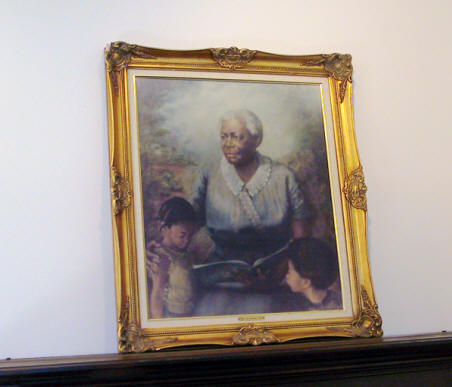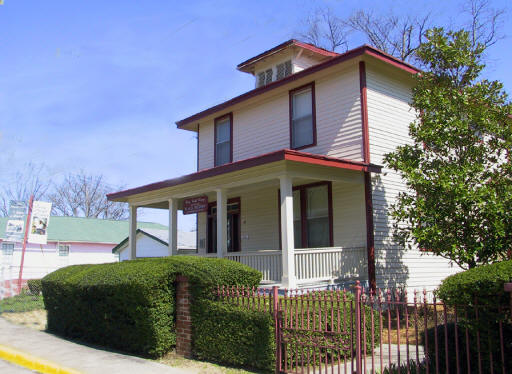|
 Both
women were African Americans who advanced the cause of equality
for their people. Both were born in central Georgia within 15
miles of one another. Both grew to adulthood in Macon, Georgia.
Both women believed strongly in the value of education for free
blacks and founded schools. Both are memorialized in interesting
places to visit in Georgia. Keep reading as I am going to tell
you of two museums to visit that will bring
the story of these amazing women to life for you.
In spite of my hunch that there had to be
a link somewhere, the only possible connection I have found was
offered by Corey Rogers, the historian at The Lucy Craft Laney
Museum of Black History in Augusta, Georgia. Corey said,
"According to one story I have been told David and Louise
gave Lucy that middle name in honor of William and Ellen Craft.
I have never been able to verify it but the Laneys
and the Crafts would have
been in Macon around the same time."
It makes a lot of sense to me. Lucy Craft
Laney was born on April 13, 1854 in Macon. At that time, Ellen
and William Craft had made their daring escape and were speaking
on the abolition circle. Their speeches were covered in the
Macon Telegraph and
all of the abolitionist press across the nation. As educated
free blacks, the Laneys would have read about the Crafts'
escape. It was one of the most talked about escapades of the
time.
To get the full picture visit the Tubman
African American Museum in Macon, Georgia.
(For
more on the Tubman Museum click here.) I first learned of
Ellen and William Craft from Dr. Andy Ambrose, the museum's
director. He showed me the exhibit and filled me in on the
story.
 |
| One of the Tubman's murals. Can
you spot Ellen Craft? |
Ellen was born in 1826 in Clinton, Georgia. Her mother. Maria,
was a mulatto slave, and
as often happened then, her father was the plantation owner,
Major James Smith. As you can imagine, Mrs. Smith was
embarrassed by Ellen. The girl was very light and strongly
resembled her white half sisters. When the Smith's daughter,
Eliza, married
Dr. Robert Collins of Macon,
Mrs. Smith gave Ellen to Eliza as a wedding present.
Ellen grew to adulthood in Macon as a
personal house slave to Mrs. Collins. She wasn't abused but she
was not free. She must have often looked at others no darker
than herself who were on the other side of that immutable color
line and envied their freedom. She matured into a large
attractive woman and was allowed to marry William Craft, the
slave of a Macon bank cashier, when she was around twenty.
William had been sold at the age of 16 to
pay his master's gambling debts and watched his younger sister
sold to someone else and taken away.
The cashier who bought William kept him apprentised to a
cabinet maker and William became a skilled craftsman. The owner
kept most of the earnings but William was allowed a little money
for himself.
 |
| Part of the Tubman's William and
Ellen Craft exhibit |
The combination of Ellen's appearance and William's savings
allowed them to take a daring action. Ellen would dress in men's
clothing and pose as a young plantation owner traveling with
"his" slave, William.
Their favored status in their respective households
allowed them to get a pass to be absent a few days near
Christmas, thus allowing a little head start before they were
missed.
On December 21, 1848, a young man dressed
in fashionable trousers
and coat with a top hat and green spectacles boarded a train
bound for Savannah at the Macon station. The young man had a
bandage around much of his lower face and his right arm in a
sling, rendering him unable to sign any papers and loath to
speak much. His large, very attentive body-servant accompanied
him. Naturally, the servant had to ride in the "Negro" car while
his master rode first class in the passenger car.
The escape was fraught with danger from
the beginning. William spotted the cabinet shop owner on the
platform looking into the cars while he waited in the "Negro"
car for the train to depart. Ellen almost died of fright when
the passenger seated next to her was a friend of her master who
had seen Ellen many times. Feigning her injury, she did not
speak to her fellow passenger.
They traveled from Savannah to Charleston
and then Philadelphia by steamer.
Ellen was treated attentively because of her injuries
but the situation was never a lark.
There were several harrowing moments during the trip
north when they felt the game was up and they were about to sent
back to their masters. Had they been apprehended they faced
possible beatings, mutilation and even death when returned to
their respective masters.
In Philadelphia on December 21, 1848
where they were welcomed by the abolitionists
community and received
their first reading lesson. They remained there three weeks and
then went on to
Boston where William worked as a cabinet maker and Ellen a
seamstress. They were popular speakers on the abolitionists
circuit. Usually William told their story and /Ellen remained on
stage silently but occasionally she also spoke. They were widely
acclaimed but their fame worked against them
when the Fugitive Slave Act was passed in 1850. They left
Boston for England just ahead of the slave catchers their
masters had sent to bring them back to Macon.
 |
Ellen in male costume with her
quote
|
They remained in England for nineteen years until 1868. They
both continued their education there. When they returned to
Georgia with three of their five children, they saw the need for
education for their newly freed people.
In 1870 they bought 1800 acres of land in Bryan County
near Savannah. There they set up the Woodville Co-operative Farm
School to help educate and find employment for freed African
Americans.
One high note of the Tubman Museum
exhibit is a image of Ellen Craft dressed in men's clothing and
showing her famous quote made just after she had arrived in
England, "For I had much rather starve in England, a free woman,
than be a slave for the best man that ever breathed upon the
American continent."
The museum is an interesting story in
itself. It began as a small local attraction in 1981 and rapidly
grew to fill the current museum's 8,500 square-foot building and
become the largest museum of its kind in the southeast. It is
slated to move into its new 49,000 square-foot museum
soon. As you can guess by the size of it, the museum is filled
with many other
exhibits relating to African American history. It's a wonderful
place to while away many hours. You will leave much the wiser
for time spent there.
 |
| Lucy Craft Laney's portrait in
musuem |
For the inside scoop on Lucy Craft Laney,
travel on to Augusta, Georgia to the Lucy Craft Laney Museum of
Black History. The museum is a treasure chest of African
American History as well as focusing on Miss Laney's
accomplishments. Lucy
Craft Laney was not a wealthy woman but her legacy is beyond
price. What she gave to the youth of Georgia was something worth
more than gold, knowledge. First and foremost , she was an
educator.
Her influence reached beyon Georgia. Ms.
Mary McCleod Bethune who later founded Bethune-Cookman College
for Blacks in Daytona,
Florida, worked with Miss Laney for a year and said of her, "I
was so impressed with her fearlessness, her amazing touch in
every respect, an energy that seemed inexhaustible and her
mighty power to command respect and admiration from her students
and all who knew her. She handled her domain with the art of a
master."
Born eleven years before the end of
slavery Lucy was the seventh of ten children born to Rev. and
Mrs. David Laney. Her father was a Presbyterian minister who
purchased his wife's freedom. Lucy was taught to read by the
sister of her mother's former master. When she was just 15, Lucy
entered the first class of Atlanta University and graduated with
three others.
 |
| Lucy Craft Laney's former home,
now the musuem |
She began her teaching career in Macon, Milledgeville, and
Savannah. Then Christ Presbyterian Church in Augusta offered her
the opportunity to begin what would become her life's work. She
founded the first school for African American children in the
church's basement on
January 6, 1883. The school began with only six students but
rapidly outgrew the little basement. When her first class
graduated two years later, there were
234 students.
Lucy knew she needed funding to secure a
larger building. She had no money but she did have boundless
faith in her project. Scraping up enough for a one way ticket to
address the Presbyterian Church Convention meeting in Minnesota.
The church convention did not fund her project but did pay her
way back to Augusta. Soon after she received a letter from Mrs.
Francine E. H. Haines, President of the Woman's Department of
the Presbyterian Church, who had heard Lucy speak at the
convention as was impressed with her zeal.
She offered $10,000 to fund the new school. Lucy was so
grateful she named the school the Haines Normal and Industrial
Institute.
 |
| Delta Sorority Room in the Lucy
Craft Laney Museum |
One of the first items you see when you enter the museum is a
life-size model of a young black woman in nursing uniform . this
represents another of Miss Laney's achievements. She founded the
Lamar School of Nursing, Augusta's
first black nursing school. She also started the first black
kindergarten After her death in October 23, 1933, her legacy
lived on in the school she had founded which was renamed Lucy
Craft Laney Comprehensive High School. Throughout Georgia and
the country, other schools have been named in her honor. In
1983, she was inducted into the Women of Achievement of Georgia.
Her home, now the Lucy Craft Laney Museum
of Black History, was damaged by fire in 1987. It was purchased
by Delta, Inc, and restored to preserve her heritage and the
struggle of African Americans to reach true equality through
education. You will find not only the story of Lucy Craft Laney
here but also other
Black citizens of Georgia who achieved a level of greatness that
might not have been possible without Miss Laney's gift of
education to young Black children.
This is one museum in Augusta you do not
want to miss. It may not be big in size but it represents the
achievements of a lady whose legacy has influenced the entire
county.
For more info:
http://www.tubmanmuseum.com
http://www.lucycraftlaneymuseum.com/
|
![]() Ads fund American Roads so please consider them for your needed
purchases.
If you enjoy the articles we offer, donations
are always welcome.
Ads fund American Roads so please consider them for your needed
purchases.
If you enjoy the articles we offer, donations
are always welcome.
|